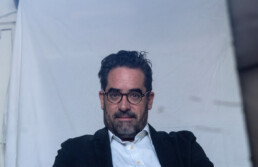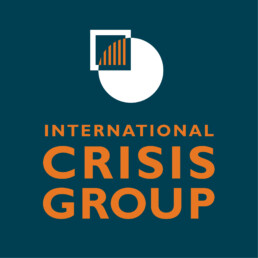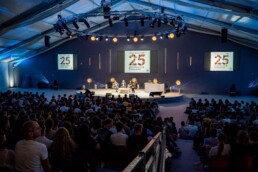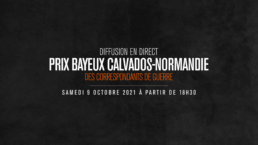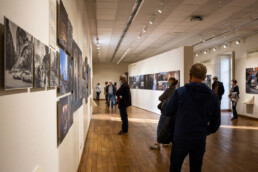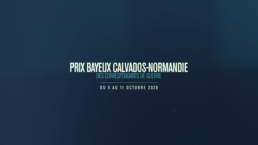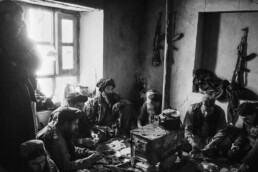Thomas Dworzak, Jury Chair for the 29th edition
31 mai 2022Non classé @en,News
Thomas Dworzak is an internationally acclaimed war photographer and a specialist in the Caucasus, who has been documenting the majority of world events since the 1990s. He has been a member of Magnum Photos since 2000 and was their president from 2017 to 2020. His work has been widely published, including by The New Yorker, Newsweek, U.S. News & World Report, Paris Match, The New York Times Magazine, Time… He won the World Press Photo award in 2001 for a report in Chechnya.
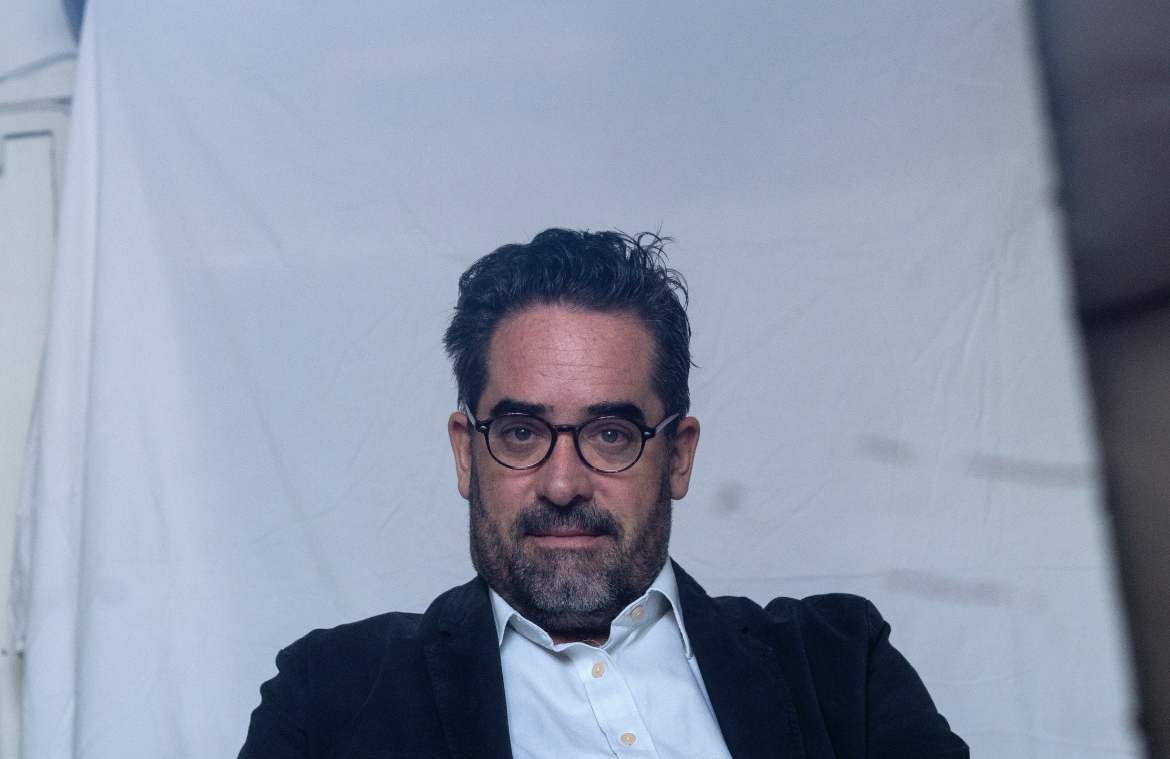 The self-taught photojournalist Thomas Dworzak (50) has spent the last thirty years travelling throughout the world, from Afghanistan to Iraq via the former Yugoslavia, Iran and the Caucasus, providing an unconventional take on the conflicts. He has been a member of the prestigious Magnum Agency since 2000 and has received many awards, notably from the World Press Photo in 2001 for his work in Chechnya.
The self-taught photojournalist Thomas Dworzak (50) has spent the last thirty years travelling throughout the world, from Afghanistan to Iraq via the former Yugoslavia, Iran and the Caucasus, providing an unconventional take on the conflicts. He has been a member of the prestigious Magnum Agency since 2000 and has received many awards, notably from the World Press Photo in 2001 for his work in Chechnya.
“I grew up in a peaceful part of Bavaria, in a provincial, very protected environment. I needed an extreme form of challenge. Photographing war is the ultimate in extreme.” Thomas Dworzak was born in Kötzting, in Germany, in 1972, and grew up in the small town of Cham, in a family of teachers. It was the height of the Cold War, and they were 7km from the iron curtain and the border with what was then Czechoslovakia.
“The wall had just come down but the East didn’t attract me. I went to Northern Ireland, Israel, Palestine. I had a vague idea of becoming a photographer. I had taken photographs but didn’t have any photographic culture or technique. It was a mixture of a wish to provoke, a desire to travel and an interest in stories, narratives, and especially the ones surrounding my maternal grandfather who had been killed in the war, and the deportation of my father’s family, which made me want to put the famous vest with pockets.”
With no network of contacts or funding, Thomas Dworzak tried to get to the former Yugoslavia, where the biggest conflict on European soil since the Second World War had just broken out. “I followed some German fascist volunteers to Croatia. I sent some small prints to the daily newspaper ’”Tageszeitung". They didn’t keep any of them.” His first break came in Prague, where he was taking language courses (he speaks French, English, Spanish and Russian). There he met the editor in chief of the only German newspaper in the city, through whom he obtained accreditation. A door-opener.
“Wostok, the smallest of the big agencies”
In 1992 he went to Moscow, and then settled in Tbilisi, in Georgia, from 1993 until 1998. “I was fascinated by the Caucasus, and spent most of my time between Grozny and Tbilisi. The Russian forces were merciless. The Chechens fought with pride. I discovered a people who were armed to the teeth, there were kalashnikovs everywhere, but they had an incredible sense of hospitality. ”He followed the conflicts in Chechnya but also in Karabakh and Abkhazia.
“In 1995, when I returned on a visit to Germany, I went to the French embassy. I asked for the yellow pages and sent applications to 40 agencies based in Paris.” Magnum politely replied that it is a cooperative with a very strict recruitment procedure. Wostok, "the smallest of the big agencies”, took him on. ”Jean-Claude Zullo and his wife, who was from Montenegro, took me under their wings. It was a small but highly respected agency. They brought me out of my isolation.” In 1999 he went to live in Paris. That same year he was called on by a friend who was a correspondent for The Guardian, and went to cover the crisis in Kosovo. “The technology boom was going on. I bought a colour scanner and a computer, and then I could be autonomous.” His work about a Serbian massacre was noticed by the U.S. News & World Report. ”I was becoming a pro. I was earning money. I was sending photos every day.”
2nd prize at Bayeux
A year later he returned to Chechnya after the Russian troops had left. “It was like day and night. Instead of being able to travel around freely as before, I had to have six bodyguards. Then an English journalist hired me as a Russian interpreter. By bringing her back to Chechnya as a fixer, I was able to take exclusive photos of the Chechen exodus. I took the best photos of my life while I was working as an interpreter.” His report “Leaving Grozny” was published by Newsweek, Paris Match, The New York Times and was awarded 2nd prize at Bayeux in 2000.
After the fall of Grozny be began work on a project looking at the impact of the war in Chechnya on the neighbouring North Caucasus. This work carried out between 1992 and 2002 was published in 2010 in the form of the book Kavkaz.
He also photographed events in Israel, the war in Macedonia, the refugee crisis in Pakistan, Baghdad under Saddam Hussein, and Iraqi Kurdistan.
Mainly based in New York since 2004, he photographed the political landscape in the USA and the consequences of the war in Iraq, to which he also devoted “M*A*S*H”, an astonishing composition combining the fictional film/series and the reality in Iraq, which was exhibited at Bayeux in 2007.
Dworzak joined the Magnum agency in 2000, becoming its president from 2017 to 2020. ”The agency wanted some new blood. I was surprised. I had thought it was only for very well established photographers, a sort of Holy Grail.”
His first book was made up of photos – that weren’t by him
After 11 September 2001 Thomas Dworzak spent several months in Afghanistan on an assignment for the New Yorker. He returned with his first book, “Taliban”. The project was surprising, provocative and subversive... The photojournalist’s project was based on portraits of members of the Taliban that he found in the back rooms of shops doing identity photos. They showed Taliban fighters against colourful, fantasy backgrounds, their eyes underlined with kohl… “First, the Taliban banned everyone from taking photos. Then they closed the photo studios, then they opened them again clandestinely, and in the end they had their photos taken. Except that no-one else was allowed to take them. So my first book is made up of photos that I didn’t take.”
Since than, he has been to Iran and Haiti. He has also produced reports on the revolutions taking place in republics of the former Soviet Union – Georgia, Kyrgyzstan and Ukraine. For his most recent project, “Feldpost” (2013-2018), he photographed the “memory” of the First World War in more than 80 countries. While covering the 2015 refugee crisis he devised “Europe – a photographic guide for refugees”, a book he produced himself and distributed free of charge to migrants.
His current project “War Games” is a long-term research project photographing all kinds of reconstructions, in the broadest sense of the term.
Thomas Dworzak is very “touched” to chair the jury at the Prix Bayeux, and says he is looking forward with impatience and curiosity to debating the way the Russian invasion of Ukraine has been covered by his colleagues. “I recently came across an old publication which had been used to illustrate an article called “Putin’s Wars”. In 2000. I feel as though I’ve made my career under the shadow of the leader. He set up an unhealthy relationship with the neighbouring countries. Somewhere between worship of a romantic idea of the Caucasus and fierce repression of any bid for freedom.”
Crisis Group sponsors the Grand format Television Prize
Crisis Group Partners with the Bayeux Award to support War CorrespondentsJournalists working in today’s conflict zones face increasing dangers in their efforts to provide the public with information. They are paying a heavy price. Not even halfway through 2022, seventeen journalists have already lost their lives in the line of duty, many of them in Ukraine.
Reflecting our deep admiration for what journalists do, and their bravery in doing it, the International Crisis Group is proud to become a partner of the Bayeux Calvados-Normandy Award for war correspondents and a sponsor of the Grand format Television Prize.
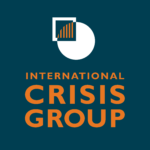 Crisis Group believes strongly in a free press, which plays a vital role in raising awareness about deadly conflicts, not only wars that dominate Western news coverage but also those that are too often neglected or forgotten, in Yemen, South Sudan or DR Congo. Journalists also explore the causes of conflict, and the motives of the combatants, often lighting the way for diplomats and others working to end wars and build peace. In this regard, the work of journalists frequently helps us at Crisis Group pursue our own conflict prevention mission.
Crisis Group believes strongly in a free press, which plays a vital role in raising awareness about deadly conflicts, not only wars that dominate Western news coverage but also those that are too often neglected or forgotten, in Yemen, South Sudan or DR Congo. Journalists also explore the causes of conflict, and the motives of the combatants, often lighting the way for diplomats and others working to end wars and build peace. In this regard, the work of journalists frequently helps us at Crisis Group pursue our own conflict prevention mission.
The Bayeux Award for war correspondents is a prestigious international annual prize for reporters covering conflicts or post-conflict situations. The Award recognises outstanding reporting about a given conflict and its impact on civilians as well as about the defence of freedom and democracy.
“I’m thrilled that Crisis Group is a partner of the Bayeux Calvados-Normandy Award”, said Comfort Ero, President and CEO of Crisis Group. “I have immense respect for the work of journalists in conflict zones, who have to navigate the dangerous front lines of conflicts and often battle disinformation”. “Video documentaries can be a powerful tool in shedding light on overlooked conflicts or complex situations as they bring a unique human perspective and can eventually contribute to helping solve them”, she added.
There are ten prizes of €7,000 in all categories of media: written press, radio, television and photography. Bayeux also honours a young reporter. An exhibition of the nominees’ work precedes the award ceremony. This year’s event will be held from 3 to 9 October 2022 in Bayeux, France.
We encourage members of the press to submit their reports or news stories by 7 June 2022. The reporting must have occurred between 1 June 2021 and 31 May 2022. For the Grand format Television Prize, the length of the report must be between 6 and 30 minutes.
Visual
The 2022 visual uses a photo from the 2021 winning report. This photograph taken by an anonymous Burmese photographer was part of his report shot between February and April 2021 during Myanmar's 'Spring Revolution'.
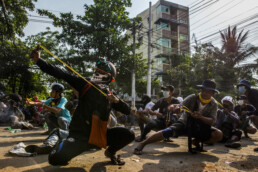
Caption: During a clash, protestors using homemade weapons such as slingshots and toy guns, defend as the security forces fired on the protest, in Tharketa township, Yangon, Myanmar, March 28, 2021. Soldiers and the police killed more than 126 people on the weekend of March 27 and March 28, according to the Assistance Association for Political Prisoners, a human rights group that is tracking the deaths. At least seven were children, including a 5-year-old boy, two 13-year-old boys and a 14-year-old girl.
The photographer grew up in Yangon and has documented important social issues in Myanmar including the military-run jade industry and the Rohingya crisis.
They have been a regular contributor to The New York Times covering Myanmar and other stories across Southeast Asia. Their work has also appeared in National Geographic Magazine, GEO, Stern, 6 MOIS, La Republica and The Wall Street Journal.
Since February 2021, when the Myanmar military staged a coup, the photographer has been covering the ongoing turmoil on assignment for The New York Times. They remain anonymous to protect their identity and avoid persecution from the authorities.
© Bayeux Award photo 2021 – Anonymous / The New York Times
Call for candidates
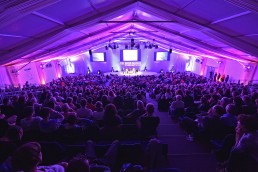
The Bayeux Calvados-Normandy award for war correspondents rewards reports about a conflict situation or its impact on civilians, or news stories involving the defence of freedom and democracy.
The report must have been made between 1 June 2021 and 31 May 2022. A €7,000 prize is awarded in each category.
The reports must be submitted to the following address by June 7th 2022: info@prixbayeux.org with a link to download the entry
The categories of media represented are: radio – photography – television (short and long formats) – written press and the young reporter prize (photo this year)
TEN PRIZES ARE AWARDED
Seven prizes awarded by the international jury
- Written Press Prize sponsored by the Calvados Department – €7,000
- Television Prize sponsored by Amnesty International- €7,000
- Radio Prize sponsored by the D-Day Landing Committee – €7,000
- Photo Prize sponsored by Nikon – €7,000
- Grand format Television Prize sponsored by International Crisis Group – €7,000
- Young reporter Prize sponsored by Crédit Agricole Normandie – €3,000
- Video image Prize sponsored by Arte, France 24 and France Télévisions – €3,000
Three special prizes
- The Ouest-France – Jean Marin Prize (written press) – €4,000
- The Public Prize (photo) sponsored by the Agence Française de Développement – €3,000
- The Normandy Region secondary School Students’ Prize (television) – €3,000
REGULATIONS
Reports published or broadcast only on digital media can apply in the same way as others (regardless of whether the report has been published in photo category).
• The Young Reporter’s Award: in 2022, the category is photo. Since there is a different category according to the years, the presented story must have been realized between 1 June 2020 and 31 May 2022.
• Written press category: the application must be made up of an article or a series of 1 to 5 articles on the same subject.
• Television category: the length of the report must be between 1 minute 30 seconds and 6 minutes. The report submitted must be identical to the broadcast piece.
• Grand format television category: the length of the report must be between 6 and 30 minutes. The report submitted must be identical to the broadcast piece.
• Radio category: the length of the report must be between 1 minute and 6 minutes. The report submitted must be identical to the broadcast piece.
• Photo category: the application comprises a report made up of 8 to 15 photos.
An exceptional occasion for school children
For the 29th edition, the HCR - the United Nations Agency for refugees - and Ouest-France newspaper are offering an exceptional educational event for middle and high school students in Normandy: “the HCR-Ouest-France Encounters”.
Partners of the Bayeux Award, the HCR and Ouest-France will be addressing school students and inviting them to meet refugees who will talk about their experiences of exile and the importance of international protection for those fleeing from war and persecution. In this age of instantaneous information, the HCR and Ouest-France aim to give young people a different understanding of the position of refugees in France and around the world.
The Nikon Encounters

Because of its history of more than a century and its values of commitment, it is in Nikon’s DNA to support photojournalism by being a partner of the Prix Bayeux.
Following the success of the first edition of the Nikon Encounters in 2021, the brand is repeating its initiative in 2022: on Friday, October 7, the public will be able to exchange with great names in photojournalism during exceptional Masterclass, testimonies and portfolio readings.
In addition, Nikon offers to pay for 12 participants for the training « REPORT IN DANGEROUS ZONES » of the Manoir created by France Médias Monde. In association with INA (the French national audiovisual archive) and with the support of Reporters without borders, the Manoir has already trained more than 360 reporters and information technicians and collaborates with many media. The training provided by the Manoir is now recognised as the reference standard in its field. While it is obvious that research and information-sharing are essential, the safety of journalists on assignment has to be both the primary concern and the starting point in the editorial process.
Because the journalist is the principal player in his or her own safety, the Manoir provides specific training and methodologies given by journalists to journalists, and brings in leading experts in the fields of health, emergency rescue and psychology.
By partnering with the Manoir, Nikon wants to support talented young photojournalists in the exercise of their profession by giving them the best possible training.
To apply, candidates must send their entry, including a CV, a motivation letter and one or more productions of a photo report produced in dangerous zones, to the address securite.academie@francemm.com before August 30, 2022.
28th edition of the Bayeux Calvados-Normandy Award: results
9 octobre 2021Non classé @en,News
More than forty war correspondents have gathered in Bayeux on October 8th and 9th to debate and award trophies in the following categories: photo, print, radio, television, grand format television, young reporter (written press) and video image. Three honorary awards have been attributed: the Regional prize for students and trainees of Normandy (television), the Public’s Choice award (photo) and the Ouest-France – Jean Marin prize (print). Presided by Manoocher Deghati, the international jury of the 28th edition of the Bayeux Calvados-Normandy Award for war correspondents has reached its verdict…
« It is exceptional to bring together forty professionals here in Bayeux. The debates are incredibly rich. For us, war reporters, who never have time to talk to each other when we are in the field, this moment is an opportunity to discuss, judge and look at our work and our colleagues’. These reports are the result of our experiences and the best of the profession.«
Manoocher Deghati
PHOTO TROPHY – INTERNATIONAL JURY
AWARDED BY NIKON
1st Prize
Anonymous Burmese photographer
for The New York Times
La révolution du printemps
MYANMAR
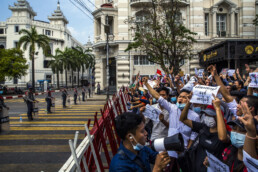
2nd Prize
Mohamed ABED
AFP
Gaza : 11 jours de bombardements
GAZA
3rd Prize
Laurent VAN DER STOCKT
Le Monde
Un mois de soulèvement palestinien
ISRAEL, OCCUPIED WEST BANK, EAST JERUSALEM, GAZA
TELEVISION TROPHY – INTERNATIONAL JURY
AWARDED BY AMNESTY INTERNATIONAL
1st Prize
Orla GUERIN and Goktay KORALTAN
BBC
Les tireurs d’élite au Yémen
YEMEN
2nd Prize
Nick PATON WALSH and Christian STREIB
CNN
Au Belarus, ils voulaient la démocratie. Au lieu de cela, ils disent qu’ils ont été battus et violés par la police.
BELARUS – UNITED KINGDOM
3rd Prize
John SPARKS ans Garwen McLUCKIE
SKY NEWS
La route de Cheli
ETHIOPIA
PHOTO TROPHY – PUBLIC’S CHOICE AWARD
SPONSORED BY THE FRENCH DEVELOPMENT AGENCY (AFD)
1st Prize
Abu Mustafa IBRAHEEM
Reuters
Gaza : 11 jours de bombardements
GAZA
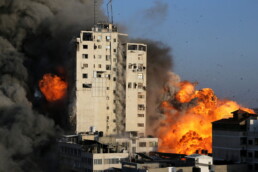
PRINT TROPHY – INTERNATIONAL JURY
AWARDED BY THE DEPARTMENT OF CALVADOS
1st Prize
Wolfgang BAUER
Zeit Magazin
Among Taliban
AFGHANISTAN
2nd Prize
Rémy OURDAN
Le Monde
Guerre au Karabakh
STEPANAKERT, NAGORNO-KARABAKH
3rd Prize
Samuel FOREY
Libération
De Jérusalem à Gaza, Palestine et Israël s’embrasent
JERUSALEM, LOD, ASHKELON, GAZA
RADIO TROPHY – INTERNATIONAL JURY
AWARDED BY THE D-DAY LANDING COMMITTEE
1st Prize
Margaux BENN
EUROPE 1
À Kandhar, des villages entiers sont devenus terrains minés
AFGHANISTAN
2nd Prize
Omar OUAHMANE
FRANCE INTER
Un carnage, deux versions : témoignages après les frappes meurtrières de Bounti
MALI
3rd Prize
Céline MARTELET and Edith BOUVIER
RTS
Des familles syriennes à la recherche de leurs proches
SYRIA
YOUNG REPORTER TROPHY (WRITTEN PRESS) – INTERNATIONAL JURY
AWARDED BY CRÉDIT AGRICOLE NORMANDIE
1st Prize
Thomas D’ISTRIA
Le Monde
Révolution dans la dernière dictature d’Europe
BELARUS
GRAND FORMAT TELEVISION TROPHY – INTERNATIONAL JURY
AWARDED BY BAYEUX CITY
1st Prize
Damir SAGOLJ and Danis TANOVIC
Al Jazeera Balkans
When we were them
BIHAC, BOSNIA-HERZEGOVINA
VIDEO IMAGE TROPHY – INTERNATIONAL JURY
AWARDED BY ARTE, FRANCE 24, FRANCE TÉLÉVISIONS
1st Prize
Damir SAGOLJ and Danis TANOVIC
Al Jazeera Balkans
When we were them
BIHAC, BOSNIA-HERZEGOVINA
PRINT TROPHY – OUEST-FRANCE – JEAN MARIN
1st Prize
Wolfgang BAUER
Zeit Magazin
Among Taliban
AFGHANISTAN
TELEVISION TROPHY – REGIONAL PRIZE FOR STUDENTS AND TRAINEES OF NORMANDY
1st Prize
Orla GUERIN and Goktay KORALTAN
BBC
Les tireurs d’élite au Yémen
YEMEN
Manoocher Deghati, Jury Chair for the 28th edition
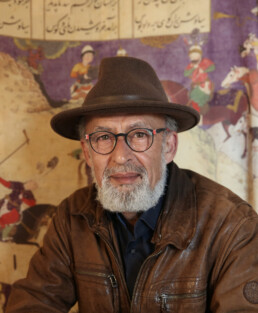
© Clara Deghati
Manoocher Deghati is 67. He is a photojournalist, war correspondent and teacher. But first and foremost Manoocher is an Iranian. And he has not seen his native country for over 35 years.
“I was destined to become a photojournalist”
“I was destined to become a photojournalist”
It all began in 1978. The young Manoocher, who had spent four years in Rome studying cinema with the ambition of becoming a cameraman, returned home to Iran. At that time there were rumblings of revolt: the people were rising up against the Shah and his repressive policies. Students had taken to the streets demanding greater freedom and democracy. As the production of films for cinema had come to a halt, Manoocher grabbed his equipment and went out to record the history of his country for posterity. Armed with his camera and a few rolls of film he photographed demonstrators and soldiers, and began working for the Sipa Press agency and AFP. The first accolades followed – he was awarded the World Press first prize in 1984 – and so did the first repressive measures: his photos of child soldiers and executions irritated the authorities. He was imprisoned, beaten and threatened. His press card was confiscated several times. In 1985 the risks had become too great and Manoocher decided to flee his country. He went into exile in France with his wife and his daughter Maral, who was only one year old at the time. This was the beginning of a long journey and a long career all over the world, sometimes marked by incredibly fortuitous timing.
“I never really had time to think about changing jobs”
“I never really had time to think about changing jobs”
After he had spent a few months in Paris, AFP asked Manoocher to take part in developing their international bureaus. He decided to go to Central America “in order to get away as far as possible from the Middle East”. Based in Costa Rica, he worked with local photographers covering the wars and social crises that were raging in Guatemala, Nicaragua and El Salvador, and he was in Panama during the invasion by the United States in 1989. After Iran, this was the second time Manoocher had found himself at the heart of the news. At the beginning of the 1990s he took over as bureau chief for AFP in Cairo, where he covered the Israeli-Palestinian conflict in particular. The photojournalist once again found himself in the thick of the news when Yasser Arafat returned to Palestine after 27 years of exile. Jerusalem, Somalia, the Gulf War, the siege of Sarajevo…Manoocher’s career continued but was temporarily halted in 1996 when an Israeli sniper shot him in the leg in Ramallah. He was very seriously wounded and had to be repatriated to France, where he spent 18 months in the military hospital of Les Invalides – the only civilian among all the veterans. He sorted his photos in his room, producing features for AFP. During his stay there he received a visit from President Jacques Chirac: he granted him French citizenship, which would make international travel much easier from then on. On his return to the field, Manoocher covered official visits abroad by the French Government. In 2000 he was a victim of the controversial visit by Lionel Jospin to Palestine: he was hit on his weakened leg by the Prime Minister’s car as it was fleeing from the stones being thrown. It was the same story again: repatriation, Les Invalides and a forced break. But in spite of the risks, Manoocher felt he had a mission and refused to give up taking photographs, speaking out and bearing witness. He had understood for many years that “photographs make an impact, they enable society to be told, they give a voice to the voiceless”.
“Taking photos of the living, the will to live, the hope”
“Taking photos of the living, the will to live, the hope”
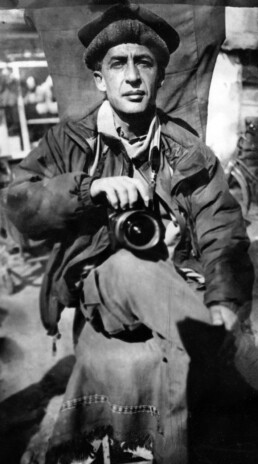
© Fardin Waezi
Always driven, Manoocher continued to cover the conflicts that marked the beginning of the 21st century, and notably the war in Afghanistan. It was there that he began a new career alongside his brother Reza, also a photojournalist: he became a teacher. In this “totally devastated” country the two men created an NGO called Aina and provided the benefit of their experience to young Afghans. The school has trained many journalists since its creation and has enabled new publications to be disseminated. Manoocher was later called upon by the UN to become a teacher within IRIN, the United Nations humanitarian press agency. Based in Nairobi, he would train more than a hundred photographers. In January 2011, with a career of 30 years behind him, he became head of Associated Press’ photography department in Cairo. Once again, his taking up of a new position coincided with a burning topic of news: the Arab Spring erupted barely 36 hours after his arrival. Egypt, Syria, Libya, Yemen, Iraq…one outbreak of demonstrations and uprisings followed another. Manoocher was managing 150 photographers and the media coverage was so dense that he was only getting 4 or 5 hours of sleep a day. Speaking several languages, he held the keys to working in this part of the world. One of his teams, of which he was head, would receive the prestigious Pulitzer Prize in 2013 for its report on Syria.
“There’s not really such a thing as retirement if you’re a photojournalist!”
“There’s not really such a thing as retirement if you’re a photojournalist!”
As the situation in Egypt was becoming more and more dangerous for journalists, Manoocher and his family left the country. He was tired, and in 2014 he decided to settle in the Apulia region of Italy. He bought a farm where he grows vines. He continues his career as a photographer surrounded by his family and his many animals, but far from war zones. In October 2021 he will be Jury Chair for the 28th Prix Bayeux Calvados-Normandie. The man who embraced his destiny with a career spanning 45 years as a photojournalist modestly calls this “A great honour”.
A FEW DATES
1954 ❱ Born in Urmia, Iran
1980 ❱ American Deadline Press Club, Special Achievement prize
1984 ❱ World Press, first prize in the news category for his photos of the Iran-Iraq war
1986 ❱ World Press Photo, third prize
2002 ❱ Set up Aïna, photography school in Kabul, Afghanistan
2004 ❱ Howard Chapnick Award for Advancement of Photojournalism
2012 ❱ Jury member, World Press Photo
2019 ❱ Publication of Iran : Rêves et dérives (Iran: Dreams and Excesses), co-published with his brother Reza, with texts by Rachel Deghati
2020 ❱ Publication of Eyewitnessed, a biographical work written by his wife Ursula Janssen, an archeologist and writer
Visual
The 2021 visual is a photo from the 2020 winning report. This photograph taken by Lorenzo Tugnoli from Contrasto for The Washington Post, was part of his report shot in Afghanistan between November 2019 and February 2020.
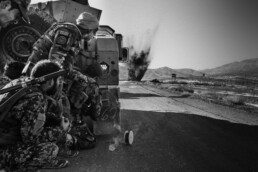
Caption: GHAZNI, AFGHANISTAN – DECEMBER 2:
A demining team of the Afghan national army detonate an Improvised explosive device that have been found on the Ghazni-Kandahar highway. A team from camp Sultan search this road for IEDs on a daily basis and often found one or many that have been set up by the Talibans the night before. Improvised explosive devices are one to the leading cause of casualties among civilians and members of the Afghan security forces.
Lorenzo Tugnoli
Lorenzo Tugnoli is an Italian photographer based in Lebanon who covers the Middle East and Central Asia. His work is an ongoing exploration of the humanitarian consequences of conflicts in the region. In 2014 he published “The Little Book of Kabul”, a book project that depicts a portrait of Kabul through the daily life of a number of artists who live in the city, in collaboration with writer Francesca Recchia.
He is a contract photographer for The Washington Post and his work has been published by The New York Times, The Wall Street Journal, and Time Magazine among others.
He joined the photography agency Contrasto in 2017.
Lorenzo is the 2019 Pulitzer Prize Winner in Feature Photography, and was awarded the 1st prize in General News Stories for the World Press Photo in the same year.
In 2020 he was awarded the 1st prize in Contemporary Issues Stories for the World Press Photo and the 2nd prize for Issue Reporting Picture Story at the PoY.
© Bayeux Award photo 2020 – Lorenzo Tugnoli
“Traces of Humanity”
—
An exhibition by Rémy Ourdan and Damir Sagolj
Hôtel du Doyen
Exhibition design: Laurent Hochberg
4 October to 21 November 2021
—
Through the history of the Jews of Sarajevo and their neighbours, here is journey that retraces a particular notion of co-existence, dignity and courage. Or, as they say in Sarajevo, a certain idea of “neighbourhood”.
What does it mean to be neighbours during the darkest moments endured by a city, a society, or a nation? What does it mean to become a Righteous in time of war?
In order to create this multimedia exhibition, inspired by a series of articles published in Le Monde in 2019 – an exhibition that combines journalistic reports, historical documents and artistic works, reporters Rémy Ourdan and Damir Sagolj travelled through two cities that symbolise the peoples of the Book and the rifts in today’s world. On one hand there is Sarajevo, the last “Jerusalem of Europe” and the first target of the return of nationalisms on the Old Continent, besieged at the end of the 20th century; and Jerusalem, centre of the world, holy city of the three monotheistic faiths and the epicentre of the turmoil in the Middle East and the Israeli-Palestinian conflict. Two cities that have captured the world’s attention and tell a universal story.
In Sarajevo, to start with the arrival of the Jews from al-Andalus, than go to the Purim revolt and the rescue of the precious Haggadah book, than evoke the help given to Jews during the Holocaust as well as the help provided by Jews to the other besieged people during the Bosnian war: this journey in the footsteps of men and women who placed their universal existential values above any conflict related to identity, politics or religion. By recounting these episodes in the history of the Jews of Sarajevo and their Bosniak, Serbian or Croatian neighbours, the authors seek to shed light on traces of humanity.
A tribute to the Righteous.
A tribute to an art of living.
Photo illustrating the article: exhibition at the Hotel du Doyen during the 2020 Bayeux Award event © Julien Buyck – Prix Bayeux 2020
The Nikon Encounters, new meeting

The Nikon Meetings
This year’s Nikon Encounters will take place on Friday 8 October at la Halle ô Grains in Bayeux and on the brand’s social networks. The programme includes portfolio reviews, equipment loan, a masterclass, personal stories and interviews that will allow the public to learn more and to exchange with these great eyewitnesses of current affairs.
MASTERCLASS with Manoocher Deghati, 11.00 to 12 noon – Open to all
An exceptional masterclass with MANOOCHER DEGHATI, President of the Jury
The masterclass will be a unique opportunity to meet this great photographer, at once a photojournalist, war correspondent and teacher, and to look back at his work and career.
Masterclass introduced by Dimitri Beck – Picture Editor, Polka
PORTFOLIO REVIEWS 1.30pm to 3.30pm – With prior registration
The reviews will be carried out by leading picture and photojournalism professionals and are intended for both amateurs and professionals who have produced photographic reports on current affairs subjects or in dangerous situations (conflict zones, demonstrations etc).
To apply, it is necessary to complete the form before September 19, 2021: https://forms.gle/RXWuHR7rVbLU8AWw7
Files can also be sent to nikonbayeux@gmail.com
The portfolio reviewers :
- Dimitri Beck – Picture Editor, Polka and for the Polka gallery
- Lionel Charrier – Picture Editor, Libération
- Pierre Terdjman – Documentary photographer, co-founder of #DYSTURB
- Olga Kravets – Photographer and director
ROUND TABLE 3.30pm to 4.30pm – Open to all
What does it mean to be a young photojournalist today? Photojournalists come to exchange and to talk about their own beginnings as photojournalists in dangerous zones: How do you start? What training do you need? What are the risks and what drives them?
LOAN OF EQUIPMENT 10.00am to 6.00pm – Open to all
Nikon is offering the opportunity to get to know the Nikon Z cameras and try them out in the streets of Bayeux for the day. Experts from Nikon will be on hand to answer questions from amateur and professional photographers.
—
Halle ô Grains
66 rue Saint-Jean
10 am to 6 pm
Free Admission
An exceptional occasion for school children
For the 28th edition, the HCR - the United Nations Agency for refugees - and Ouest-France newspaper will be organizing an outstanding event for middle and high school students in Normandy, “the HCR-Ouest-France Encounters” this year focused on the 70th anniversary of the Geneva Convention.
As partners of the Bayeux award, the HCR and Ouest-France will be addressing school students and inviting them to meet refugees who will talk about their experiences of exile and the importance of international protection for those fleeing from war and persecution. In this age of instantaneous information, the HCR and Ouest-France aim to give young people a different understanding of the position of refugees in France and around the world.
27th edition of the Bayeux Calvados-Normandy Award: results
More than thirty war correspondents have gathered in Bayeux on October 9th and 10th to debate and award trophies in the following categories: photo, print, radio, television, grand format television, young reporter (photo) and video image. Three honorary awards have been attributed: the Regional prize for students and trainees of Normandy (television), the Public’s Choice award (photo) and the Ouest-France – Jean Marin prize (print). Presided by Ed Vulliamy, the international jury of the 27th edition of the Bayeux Calvados-Normandy Award for war correspondents has reached its verdict…
« I am absolutely exhausted, not for lack of sleep but for the intensity of what we’ve been doing. It is the honor of a lifetime to chair the jury. The Prix Bayeux is the epicentre, the centre of gravity of our profession. What is wonderful about the deliberations of the jury is that there is nor right or wrong : we have to make a judgement but it is impossible by definition. We are choosing between best and better.«
Ed Vulliamy
PHOTO TROPHY – INTERNATIONAL JURY
AWARDED BY NIKON
1st Prize
Lorenzo TUGNOLI
CONTRASTO for The Washington Post
La guerre plus longue
AFGHANISTAN
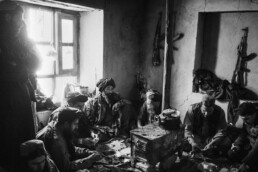
2nd Prize
Anthony WALLACE
AFP
Hong Kong, une révolte populaire
HONG KONG
3rd Prize
Laurent VAN DER STOCKT
Le Monde
Contestation irakienne : les jeunes exigent le changement
IRAQ
TELEVISION TROPHY – INTERNATIONAL JURY
AWARDED BY AMNESTY INTERNATIONAL
1st Prize
John SUDWORTH and Wang XIPING
BBC
Les familles ouïghoures
CHINA-TURKEY
2nd Prize
Julie DUNGELHOEFF, Catherine NORRIS TRENT and Abdallah MALKAWI
France 24
Libye : piège infernal
LIBYA
3rd Prize
Nicolas JOXE, Abdulrazzak MADI, Fajr ORABY, Belal ALBAYUS, Obaida ALNABWANI and Nisal MUHANA
SMART NEWS/ARTE
Syrie : les civils sous les bombes près d’Alep
SYRIA
PHOTO TROPHY – PUBLIC’S CHOICE AWARD
SPONSORED BY THE FRENCH DEVELOPMENT AGENCY (AFD)
1st Prize
Anthony WALLACE
AFP
Hong Kong, une révolte populaire
HONG KONG
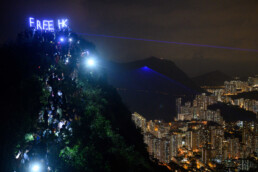
PRINT TROPHY – INTERNATIONAL JURY
AWARDED BY THE DEPARTMENT OF CALVADOS
1st Prize
Allan KAVAL
Le Monde
Dans le nord-est de la Syrie, la mort lente des prisonniers djihadistes
SYRIA
2nd Prize
Fritz SCHAAP
Der Spiegel
Rain wars
CHAD
3rd Prize
Jack LOSH
Foreign Policy
Les gardes forestiers d’Afrique centrale sont aussi menacés que les animaux qu’ils protègent
CENTRAL AFRICAN REPUBLIC
RADIO TROPHY – INTERNATIONAL JURY
AWARDED BY THE D-DAY LANDING COMMITTEE
1st Prize
Sonia GHEZALI and Shahzaib WAHLAH
RFI
Afghanistan : après l’attaque de la maternité de MSF
AFGHANISTAN
2nd Prize
Gwendoline DEBONO
Europe 1
Une frappe, des fractures : la mort du Général Soleimani en Irak
IRAQ
3rd Prize
Emilie BAUJARD
RTL
Les indésirables d’Hassaké
SYRIA
YOUNG REPORTER TROPHY (PHOTO) – INTERNATIONAL JURY
AWARDED BY CRÉDIT AGRICOLE NORMANDIE
1st Prize
Anas ALKHARBOUTLI
DPA
La guerre en Syrie
SYRIA
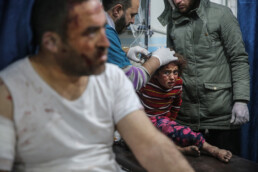
GRAND FORMAT TELEVISION TROPHY – INTERNATIONAL JURY
AWARDED BY BAYEUX CITY
1st Prize
Suzanne ALLANT, Yamaan KHATIB and Fadi AL-HALABI
Découpages pour Arte Reportage
Syrie, dans le piège d’Idlib
SYRIA
VIDEO IMAGE TROPHY – INTERNATIONAL JURY
AWARDED BY ARTE, FRANCE 24, FRANCE TÉLÉVISIONS
1st Prize
Olivier JOBARD
MAGNETO PRESSE pour ARTE/France 24
Yémen : à marche forcée
YEMEN
PRINT TROPHY – OUEST-FRANCE – JEAN MARIN
1st Prize
Allan KAVAL
Le Monde
Dans le nord-est de la Syrie, la mort lente des prisonniers djihadistes
SYRIA
TELEVISION TROPHY – REGIONAL PRIZE FOR STUDENTS AND TRAINEES OF NORMANDY
1st Prize
John SUDWORTH and Wang XIPING
BBC
Les familles ouïghoures
CHINA-TURKEY

